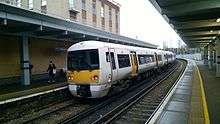British Rail Class 376
The British Rail Class 376 is a model of electric multiple-unit passenger train manufactured by Bombardier Transportation at its Derby Litchurch Lane Works. It is part of the Electrostar family, which are the most common EMUs introduced since the privatisation of British Rail. The units were ordered by Connex South Eastern, introduced in 2004/2005 by South Eastern Trains originally to replace Class 465 and Class 466 to be transferred to the Outer Suburban services to Kent to replace the Class 423 slam-door trains.
| British Rail Class 376 | |
|---|---|
Southeastern 376033 near Hither Green in 2011 | |
 The interior of a Southeastern Class 376 | |
| In service | 16 August 2004 – present |
| Manufacturer | Bombardier Transportation |
| Family name | Electrostar |
| Replaced | |
| Constructed | 2004–2005[1] |
| Number built | 36 units |
| Formation | 5 cars per unit DMOS-MOS-PTOS-MOS-DMOS[1] |
| Capacity | 228 seats[1] |
| Operator(s) | Southeastern |
| Specifications | |
| Maximum speed | 75 mph (121 km/h)[1] |
| Electric system(s) | 750 V DC third rail |
| Current collection method | Contact shoe |
| Coupling system | Dellner[1] |
| Track gauge | 1,435 mm (4 ft 8 1⁄2 in) standard gauge |
Design

.jpg)
It is a derivative of the Class 375 Electrostar specially designed for use on the high-volume metro routes running from Central London, and through Southeast London in the United Kingdom. The changes are mostly focused on increasing the trains’ capacity and decreasing station dwell times. The Class 376’s doors are wider to allow more passengers to board at once, and are metro-style sliding pocket doors which are faster and more reliable than the Class 375s plug doors, although they do not close flush with the bodyside and hence are less aerodynamic and do not provide as much thermal insulation. The units have 2 sets of double doors per side in each carriage. Also, these trains do not have air conditioning, with hopper style windows available for ventilation. In order to provide more standing room, the trains also have fewer seats, more handrails, and no on-board toilets (South Eastern promised to provide additional facilities in their stations to compensate) and, as a consequence, these trains are limited to in-service journey times of 1 hour.
Class 376 units have five coaches, and unlike the Class 375, they have full-width cabs instead of gangways at the ends of the train; as a result, it is not possible to walk between two coupled Class 376 units. The cab front is also smooth and ‘step free’ to reduce the dangerous problem of ‘train surfing’ in Southeast London.
Like all new trains in the United Kingdom using third rail power, one carriage in each unit has a recess in its roof where a pantograph can be fitted, so as to allow for future conversion to overhead AC traction power and/or make the unit dual voltage.
Routes
The Class 376s operate on the high-density routes in South East London and Kent with their main roles being London to Dartford and London to Orpington
Maintenance
All Class 376 trains were allocated to Slade Green depot, but due to the high volume of work there, these trains are sent to Ramsgate for routine maintenance.[2]
Fleet details
| Class | Operator | No. Built | Year Built | Cars per Unit | Unit nos. |
|---|---|---|---|---|---|
| Class 376 | Southeastern | 36 | 2004-05 | 5 | 376001 - 376036 |
![]()
In 2017, 376 001 was named Alan Doggett after a railway employee.
Accidents and incidents
A train formed by units 376 002 and 376 035 was one of eleven trains that stalled and became stranded in the Lewisham area on 2 March 2018. Passengers evacuated the train after conditions on board became intolerable due to lack of heating, toilets and communication.[3][4]
On 10 July 2018, 376 030 partially derailed at Grove Park depot.[5]
References
- Marsden, Colin J. (2007). Traction Recognition. Ian Allan Publishing. p. 210. ISBN 978-0-7110-3277-4.
- "CLASS 376 MOVES TO RAMSGATE". Southern Electric Group. Retrieved 20 September 2018.
- Harris, Nigel. "Disastrous disruption plans. Did no one say 'It's nearly three hours - with no toilets'?". Rail. Peterborough: Bauer Consumer Media Ltd (848): 3. ISSN 0953-4563.
- "Self-detrainment of passengers onto lines that were still electrically live at Lewisham, London 2 March 2018" (PDF). Rail Accident Investigation Branch. Retrieved 25 March 2019.
- McInerney, Liam (10 July 2018). "Southeastern delays after train derailment at Grove Park". News Shopper. Retrieved 20 September 2018.
External links
| Wikimedia Commons has media related to British Rail Class 376. |